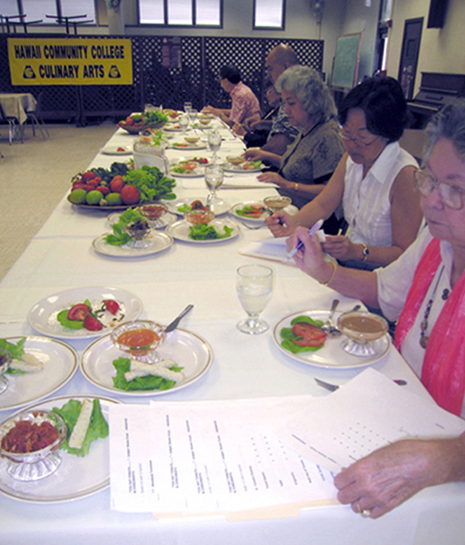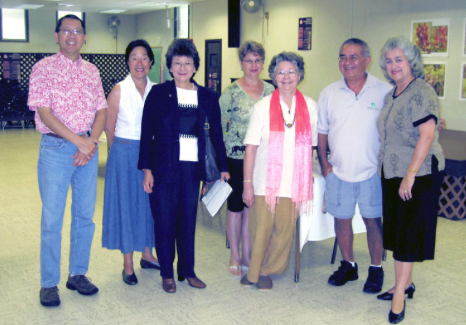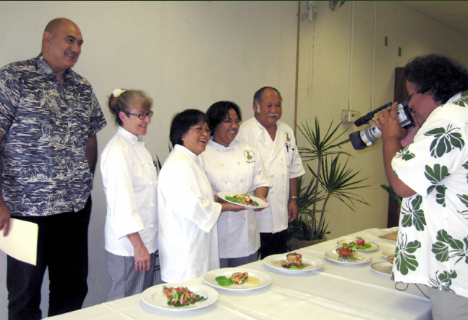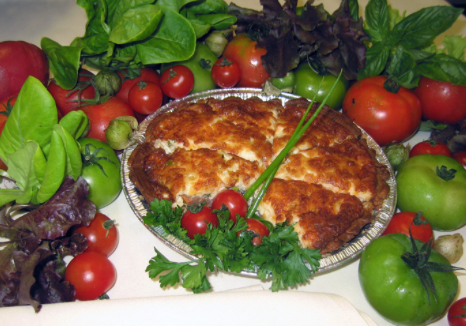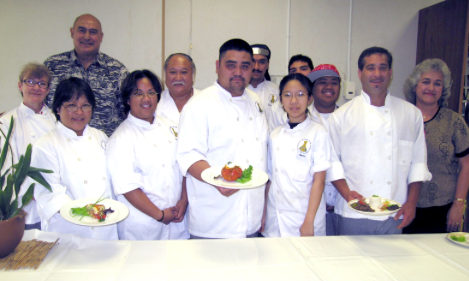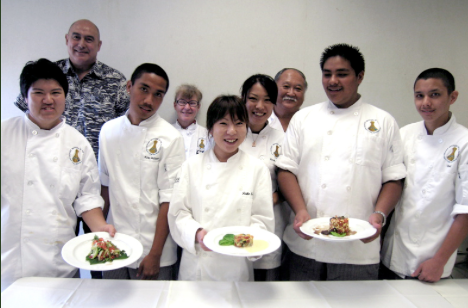Let me tell you – when Hamakua Springs hosts a cookout, it’s not just any old backyard-type event where somebody slaps together a few burgers.
Chef Alan Wong recently made his annual trek from Honolulu to the Hamakua coast, bringing chefs and other personnel from his restaurants to visit and meet the farmers whose products they cook with everyday.
And while they were here making the rounds and visiting their farmer friends, they came to Hamakua Springs and prepared a 12-course feast—a thank you—for friends and farmers here who, incidentally, supplied most of the fresh local ingredients.

Alan Wong cooking
Richard pointed out that Chef Alan and his crew created a really unique atmosphere for this group of farmers. Though they all know each other, most usually only see each other in work-related situations—maybe on a tour, or while showing their products at a booth, or at a meeting. “This was the first time they all could talk story in a purely social situation,” he said, “and that was very special.”
The event was called a “cookout,” but that doesn’t properly describe this memorable dinner. Wanda Adams of the Honolulu Advertiser put together a video about the event, which you can view here.
The food was absolutely delicious. There were “beer sausage” pupus, with grass-fed beef from the North Shore Cattle Company, and smoked pork lechon salad. Garlic bread was topped with Dick and Heather Threlfall’s Hawai‘i Island Goat Dairy goat cheese, and there was a Hamakua Springs tomato salad with crispy pipikaula. One really popular (and delicious) appetizer was the guava-smoked Big Island goat cheese on shiso leaves and topped with pancetta. Yum.

Guava-smoked Hawai‘i Island Goat Dairy cheese on shiso leaves with pancetta. Photo by Macario
Our smoked sausage, made by Kimo and Tracy and “The Pig Man” Alvin Jardine, was on the menu, as well as grilled, Big Island ribeye and grilled strip loin from Kulana Meats, and a grilled rib steak with chili lemongrass and goat cheese dressing.
In addition to their other varieties, Bob and Janice Stanga of Hamakua Mushrooms brought Chef Alan samples of their new product, the endemic Pepeiao mushroom, which is not available on the market yet but coming soon. It ended up in a mushroom and snow pea chow fun dish.
There were many, many other delicious dishes, too, including fresh prawns from the farm’s streams, fish, and an unbelievable paella.


Paella. Photo by Macario
Our chef friends cooked with Wailea Agricultural Group’s fresh, tasty Hawaiian Heart of Palm, and every kind of Hamakua Springs produce.
Chef Alan even used Hamakua Springs bananas, cooked in butter and sugar, in the otherwise traditional s’mores (made of local chocolate) that they served at the end of the meal. In case anyone was still hungry.

photo by Macario
All of the incredible food was prepared by the chefs who work at The Hualalai Grille by Alan Wong, as well as at Alan Wong’s Restaurant, on King Street in Honolulu, which was recently named by Gourmet magazine as the 8th best restaurant in the country.
What an incredible crew it was at work under the green- and white-striped tent. Some wore their street clothes and looked like the guy/girl next door—but it was clear they were not. These were professionals.

It was interesting to watch these chefs, accustomed to working in the most upscale kitchens, working out-of-doors in a makeshift kitchen on a gravel lot. Nobody missed a beat. There were coolers and big pots everywhere, and most of the chefs had white- and green-striped kitchen towels tucked into a pocket. Skillets rested upside down atop other skillets atop propane grills, acting as lids. As a dish neared completion, its cook would bring a spoonful over to Alan Wong – “Chef,” they call him – who, I noticed, would conduct the definitive taste test.
So many people joined us and helped make it what it was. From the Hawai‘i Community College culinary program there was Chef Allan Okuda and his wife Kay, Chef Sandy Barr and six students. In addition to Wanda Adams from the Advertiser, other food writers in attendance were Sonia Martinez and Joan Namkoong.
Harold and Eric Tanouye from Green Point Nurseries brought stunning flower arrangements. From the farm, in addition to Richard, June, Kimo and Tracy, there was Chris Respicio, Florence Lovell, Ida Castillo, Wilfred Hansen, Downey Kajime and Susie White. Charlotte and Rodrigo Romo and their girls Sydney and Hana were there, in addition to myself, my daughter Emma Rose and my husband Macario, who photographed the food.
Richard’s mom was there, too. Mrs. Ha doesn’t go out much at nights. But Richard asked her if she wanted to come to the cookout and she did. She said the food was delicious and that Alan and lots of others went over to talk with her.
On the way home, Richard’s mom told him, “Do you remember how we didn’t even have a tractor in the beginning? Now I’m taking home a plate from Chef Alan Wong.” They laughed and talked about the old days. Richard’s mom was there helping out at the farm’s very beginning and she is still involved. See How It All Started, Part One.
It was a magnificent offering by Chef Alan and his people. There was so much generosity, and aloha, in the air, and everyone present seemed to feel as I did – that we were absolutely honored to be in the presence of such great cooks, who were working so hard to prepare us such unbelievably delicious food, the likes of which is rarely seen outside of very upscale restaurants. Walking through that beautiful buffet line and loading up a plate with some of the best food I can recall having (and then going back for some more) was a thrill.

photo by Macario
Chef Alan and associates (Dan Nakasone, Leigh Ito, Wade Ueoka, Michelle Karr, Kerry Ichimasa, Miya Nishimura, Nicole Tajima, James Ebreo, Allen Hess, Liz Suarez, Valerie and Chris): We thank you for the gift of your time, energies, enthusiasm and talents, and especially for the tremendous feast. – posted by Leslie Lang










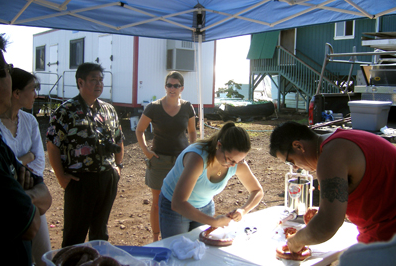
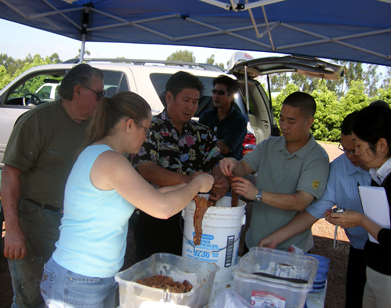
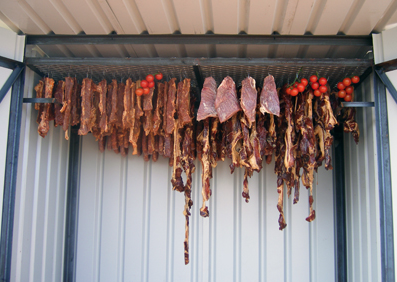

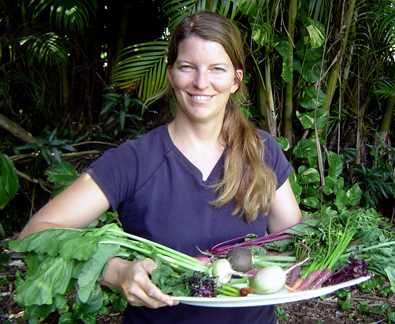
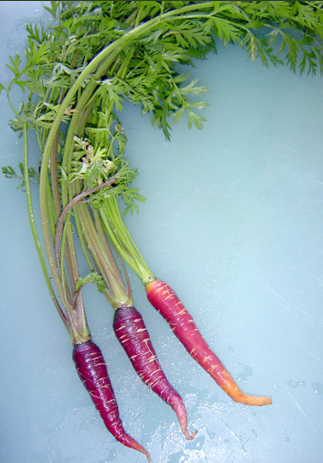
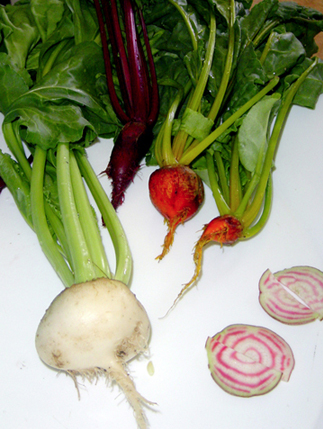 “It’s so fun to grow something for the first time,” she says. “It’s all this different, funny-looking stuff, like stripey vegetables. A lot of these carrots we’re growing are higher in Beta-carotene and Vitamin A than the usual. In the stores, a lot of farms tend to do just one variety based on performance and disease-resistance, rather than color. We will be accomplishing the goal of getting more nutrients out to people by growing these varieties.”
“It’s so fun to grow something for the first time,” she says. “It’s all this different, funny-looking stuff, like stripey vegetables. A lot of these carrots we’re growing are higher in Beta-carotene and Vitamin A than the usual. In the stores, a lot of farms tend to do just one variety based on performance and disease-resistance, rather than color. We will be accomplishing the goal of getting more nutrients out to people by growing these varieties.”